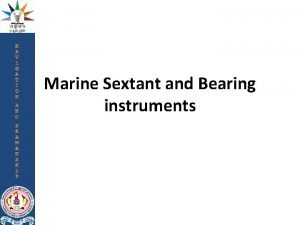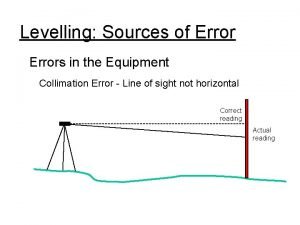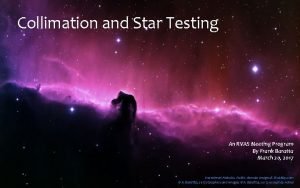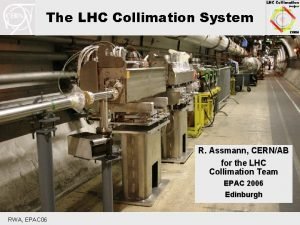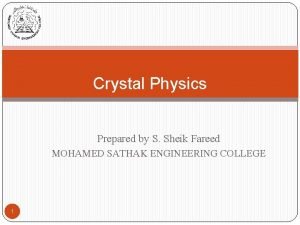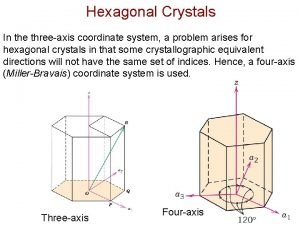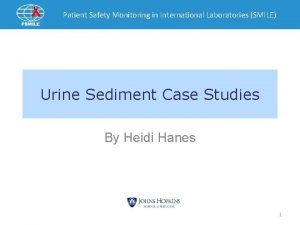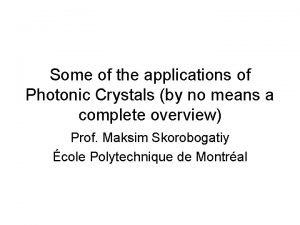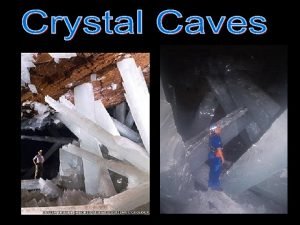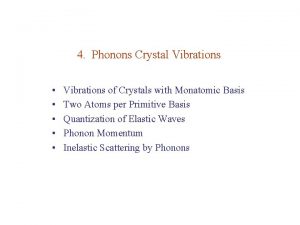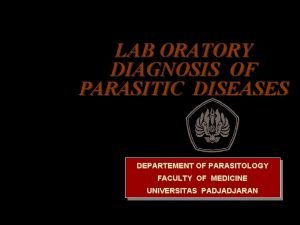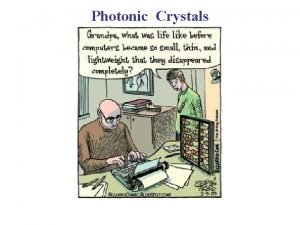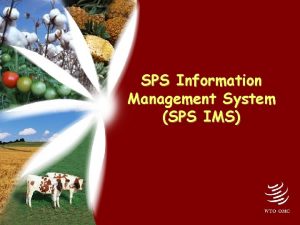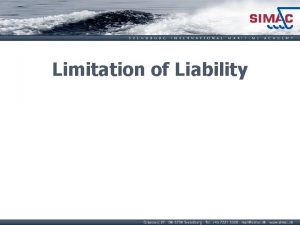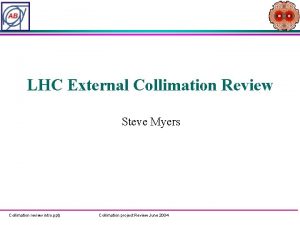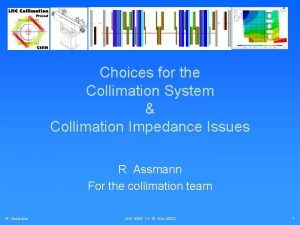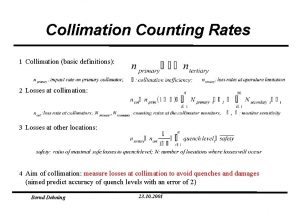SPS collimation simulation requirements for crystals Limitation on










- Slides: 10

SPS collimation simulation → requirements for crystals ----------------------------Limitation on the crystal imperfections 1. Amorphous layer Mechanically disrupted layer can be avoided Thickness of native Si oxide layer due to contact with air is about 2 nm Native layer can be also chemically removed before the installation 2. Crystal miscut Angle between the crystal planes and surface 3. Anticlastic bending It is parasitic one for QM crystal 4. Crystal torsion Orientation of crystal planes is changed along vertical direction

Simulation scenario ------------For particle tracking → (1) liner approach was used for SPS (2) the only aperture restrictions are in the crystal collimation area We transport particles along SPS through two azimuths BC → TAL → BC using two transfer matrices M(6, 6) Start point → BC azimuth Final points → (1) absorption in TAL (2) Inelastic interaction in BC Collimation efficiency losses only due to inelastic nuclear interactions

Initial distribution of halo particles -------------------Normalized betatron amplitude at BC → xm=xbc+∆xm Amplitude increase Δxm is a random value P(∆xm)=exp(-∆xm/λ), λ=0. 1 μm, ∆xm=–λ∙ln(ξ 1) Interval betatron phases of particles hit BC ∆φ=arccos(1/(1+∆xm/xbc)) Random phase from this interval Φ(ξ 2)=2∙∆φ(ξ 2 -0. 5) Horizontal coordinates x(ξ 1, ξ 2)=xm(ξ 1)∙cos(φ(ξ 2)) x΄(ξ 1, ξ 2)=-xm(ξ 1)/βx (sin(φ(ξ 2)+α∙cos(φ(ξ 2))) Distributions of vertical coordinates (y, y΄) and momentum deviation δ=∆p/po P(y)=P(y΄)=P(δ)=δ(0)

Results for Strip Crystal 1 in 2009 -------------------Straight comparison can be made only for the angular dependence of beam losses in crystal Alignment positions BC and TAL are about 4σx Collimation positions BC → - 0. 5 mm, TAL → +1. 5 mm Loss reduction in channeling experiment → 5, simulation → 36 Discrepancy reason → Strip crystal has a large torsion + goniometer inaccuracy

Results for Strip Crystal 1 in 2009 -------------------Different shift, width and efficiency of deflected beam were caused by different orientations of the crystal Distribution on TAL Number of passages Impact parameter with BC

Simulation for Strip Crystal 1 with torsion -------------------Torsion values → 20 μrad/mm (1) and 40 μrad/mm (2) Critical angle → θc=19. 5 μrad Particle losses at θo=0 are increased by 2. 7 for torsion 1 and by 6. 6 for torsion 2 Torsion for Strip Crystal 1 can be about 20 μrad/mm + goniometer inaccuracy → larger than ± 20 μrad

Simulation for Strip Crystal 1 with amorphous layer -------------------------(1) Native amorphous layer thickness − 2 nm, λ=0. 5 nm (2) Amorphous layer thickness − 1 μm, λ=0. 1 μm Loss increase at θo=10 μrad (1) 41% , (2) 158% Loss increase at θo=0 (1) 16% , (2) 300% Loss increase at θo=-10 μrad (1) 1. 8% , (2) 150% First passage is unsuccessful Difference in the crystal length passed in the cases (1) and (2) Loss value for the ideal crystal at θo=0 → 2. 8% of amorphous 0. 16% of all beam halo

Results for QM Crystal 3 in 2010 -------------------Data of the run in September 1 -2 Distances from the orbit for BC and TAL were about two times larger Offset between BC and TAL was about 1. 55 mm Loss reduction in channeling experiment → 16 -20, simulation → 33 Discrepancy at θo=0 was decreased New IHEP goniometer has smaller inaccuracy → ± 10 μrad + good QM crystal However, discrepancy with experiment is observed in VR area

Simulation for QM Crystal 3 with anticlastic bending ------------------------Anticlastic curvature → 25. 6 μrad/mm (1) and 43 μrad/mm (2) Critical angle → θc=19. 5 μrad (1) is corresponded to the change rate of the beam envelop direction → –α/β Anticlastic reduces the losses for negative angles and increases for positive ones near θo=0 ± 10 μrad the losses are about the same Loss increase at θo=0 → (1) -14% , (2) -17%

Simulation for QM Crystal 3 with miscut ------------------------Miscut angle for QM crystal 3 → θm=92 μrad Loss increase at θo=10 μrad 5. 6% Loss increase at θo=0 29% Loss increase at θo=-10 μrad 44% Loss value for the ideal crystal at θo=0 → 3% of amorphous 0. 3% of all beam halo
